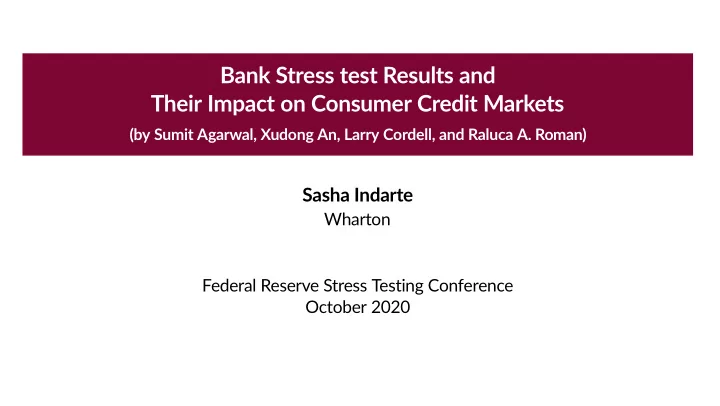

Bank Stress test Results and Their Impact on Consumer Credit Markets (by Sumit Agarwal, Xudong An, Larry Cordell, and Raluca A. Roman) Sasha Indarte Wharton Federal Reserve Stress Testing Conference October 2020 Sasha Indarte, Duke Fuqua 1
Overview • Q: how does overestimating stress test results affect banks’ consumer lending? ◮ Credit limits per capita ◮ Credit card (CC) APRs , rewards (miles + cash back) and promotions ◮ New CC borrower utilization , debt , delinquency ◮ Mortgages • Motivation: sheds light on impact of stress test on bank risk mgmt and credit access • Approach: compare lending for banks with high vs. low capital gap ◮ Constructed from confidential stress test data ◮ Compare banks’ own forecast of worst-case scenario capital to Fed’s • Comments: interpretation, policy implications, & future work Sasha Indarte, Wharton 1
Overview • Q: how does overestimating stress test results affect banks’ consumer lending? ◮ Credit limits per capita ↓ ◮ Credit card (CC) APRs ↓ , rewards (miles + cash back) and promotions ↑ ◮ New CC borrower utilization ↑ , debt ↓ , delinquency ↓ ◮ Mortgages: similar effects • Motivation: sheds light on impact of stress test on bank risk mgmt and credit access • Approach: compare lending for banks with high vs. low capital gap ◮ Constructed from confidential stress test data ◮ Compare banks’ own forecast of worst-case scenario capital to Fed’s • Comments: interpretation, policy implications, & future work Sasha Indarte, Wharton 1
Comment 1: is bank credit access affected by stress tests? (exclusion restriction) • External creditors (e.g. wholesale finance) may react to stress test results • If bad result ⇒ less funding, a lack of funds could reduce lending ◮ Could explain riskiness patterns if marginal borrower is riskier than average ◮ Alternative explanation to risk management • Note: policy-relevant treatment effect is the general equilibrium outcome ◮ Question of mechanisms – do credit markets help enforce microprudential policies? • Test: run a bank-month level analysis with non-deposit funding sources as outcomes Sasha Indarte, Wharton 2
Comment 2: assessing threats to identification • Key assumption: capital gap is uncorrelated with other drivers of bank lending • Demand unlikely a concern – households likely inattentive to/unaware of stress tests • Threats to identification center on whether high gap banks are systematically different ◮ Optimistic banks more more willing to lend to risky households? (understate causal effect) ◮ Are pessimistic banks reducing lending overall? (understate causal effect) • Placebo test: does the gap predict differences in lending prior to the announcement? Sasha Indarte, Wharton 3
Comment 3: equilibrium effects Credit supply is important in shaping equilibrium CC borrowing Fraction of HH with credit card debt 60% 50% 40% 30% p20 p40 p60 p80 20% 10% $0 $50,000 $100,000 $150,000 $200,000 $250,000 Annual Income Source: Bornstein and Indarte (2020), 2017 PSID data. Sasha Indarte, Wharton 4
Comment 3: equilibrium effects • ∼ 80% of banks are over-optimistic • Does a back of the envelope calculation suggest stress test announcements on average reduce lending? • Does CC lending fall in equilibrium or is it just reallocated across banks? • Test: compare lending at the county level , using local exposure (e.g. size-weighted gap) ◮ Is the magnitude similar what’s implied by the back of the envelope calculation from the bank-county-level estimates? Sasha Indarte, Wharton 5
Comment 4: possible welfare implications from a shift in business model • Shift away from risky borrowers towards inelastic transactors ◮ Change in rewards and borrower characteristics consistent w/ shift towards sophisticated households (Ru and Schoar, 2016) • Possible negative welfare implications of stress tests ◮ CC access has important consumption-smoothing benefits (Herkenhoff and Raveendranathan, 2019; Indarte and Bornstein, 2020) ◮ Market power in CC market ⇒ consumer welfare loss (Herkenhoff and Raveendranathan, 2019; Nelson, 2020) • What are the net welfare effects of stress testing, taking into account these trade-offs? • Estimates from this paper would be useful for exploring this in a model Sasha Indarte, Wharton 6
Conclusion • New evidence that stress tests impact consumer lending • Over-optimistic about capital adequacy ⇒ reduce lending, esp. to riskier households • Amazing data and clever empirical approach • Thorough look at a range of consumer credit outcomes • Future work: GE implications? Welfare implications? Sasha Indarte, Wharton 7
Recommend
More recommend